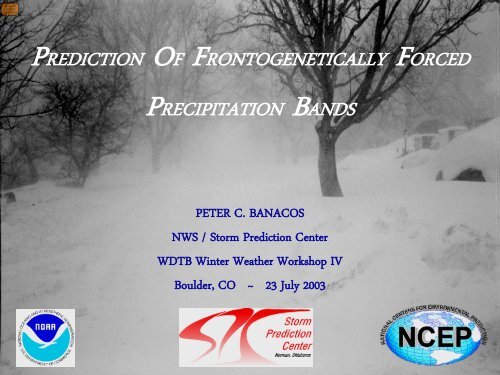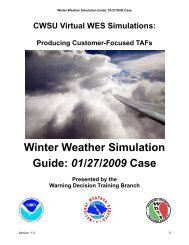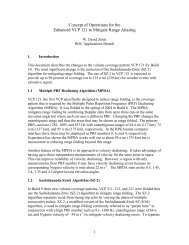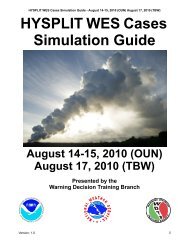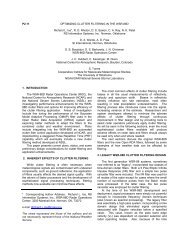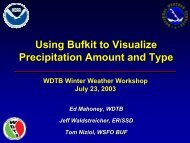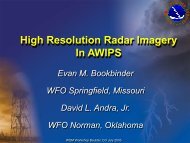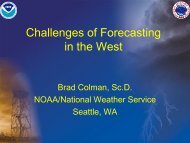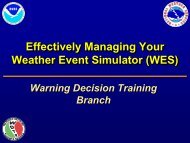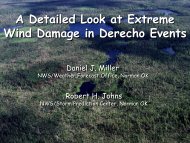Prediction of Frontogenetically Forced Precipitation Bands
Prediction of Frontogenetically Forced Precipitation Bands
Prediction of Frontogenetically Forced Precipitation Bands
Create successful ePaper yourself
Turn your PDF publications into a flip-book with our unique Google optimized e-Paper software.
PREDICTION OF FRONTOGENETICALLY FORCED<br />
PRECIPITATION BANDS<br />
PETER C. BANACOS<br />
NWS / Storm <strong>Prediction</strong> Center<br />
WDTB Winter Weather Workshop IV<br />
Boulder, CO ~ 23 July 2003
OUTLINE<br />
I. Frontogenesis<br />
• …where it fits in the forecast process<br />
• kinematics and dynamics <strong>of</strong> frontogenesis<br />
• synoptic pattern recognition<br />
• Case #1 – examine band formation<br />
II.<br />
Mesoscale Banding Characteristics<br />
• modulation by local wind pr<strong>of</strong>ile<br />
• col point al<strong>of</strong>t<br />
• modulation by stability<br />
• Case #2 – numerical model considerations
INGREDIENTS BASED FORECASTING<br />
Purpose: To focus the forecaster on the necessary conditions (“ingredients”) needed for a<br />
specific meteorological event to take place.<br />
Frontogenesis is a lifting/forcing mechanism.
Frontogenesis (definition)<br />
F<br />
=<br />
D<br />
Dt<br />
∇pθ<br />
(S. Petterssen 1936)<br />
‣ The 2-D scalar frontogenesis function (F ) – quantifies the change in<br />
horizontal (potential) temperature gradient following air parcel motion :<br />
F > 0 frontogenesis, F < 0 frontolysis<br />
‣ Conceptually, the local change in horizontal temperature gradient near<br />
an existing front, baroclinic zone, or feature as it moves.
Vector Frontogenesis Function<br />
F<br />
=<br />
F n +<br />
n<br />
F<br />
s<br />
s<br />
(Keyser et al. 1988, 1992)<br />
D<br />
F n = − ∇pθ<br />
Dt<br />
D<br />
F s = n ⋅( k × ∇pθ<br />
)<br />
Dt<br />
F is <strong>of</strong> fundamental importance…<br />
Change in magnitude<br />
‣ Corresponds to vertical motion on the frontal scale<br />
(mesoscale bands)<br />
Change in direction (rotation)<br />
‣ Corresponds to vertical motion on the scale <strong>of</strong> the<br />
baroclinic wave itself<br />
‣ Galilean invariant<br />
‣ full wind generalization <strong>of</strong> the quasi-geostrophic Q-vector
Kinematics <strong>of</strong> Frontogenesis<br />
The geometry <strong>of</strong> the horizontal flow has a first-order influence on F in most<br />
situations.<br />
Examine separate contributions <strong>of</strong><br />
horizontal divergence, deformation,<br />
and vorticity to the field <strong>of</strong><br />
frontogenesis.<br />
Note: Will focus exclusively on the Petterssen 2-D scalar<br />
(F n )<br />
frontogenesis
Horizontal Divergence<br />
Divergence (Convergence) acts frontolytically (frontogenetically),<br />
always, irrespective <strong>of</strong> isotherm orientation.<br />
F0
Horizontal Deformation<br />
F>0<br />
Flow fields involving deformation acting<br />
frontogenetically are prominent in the majority<br />
<strong>of</strong> banded precipitation cases.
Horizontal Deformation (cont.)<br />
F
Vertical Vorticity<br />
F=0<br />
Pure vorticity acts to rotate isotherms, cannot<br />
tighten or weaken them.
Other Contributing Factors to Frontogenesis<br />
The kinematic field, and deformation in particular, plays the<br />
most prominent role in the 2-D frontogenesis al<strong>of</strong>t.<br />
Other processes such as diabatic heating and tilting effects may<br />
also contribute to frontogenesis.<br />
Examples:<br />
‣ differential solar heating<br />
‣ Latent heating with convective motions<br />
(documented in coastal frontogenesis process).
Dynamics <strong>of</strong> Frontogenesis<br />
(vertical circulation)<br />
Flow field<br />
dominated by<br />
deformation.
Dynamics <strong>of</strong> Frontogenesis (cont.)<br />
Ageostrophic circulation develops as a response to increasing<br />
temperature gradient.
Dynamics <strong>of</strong> Frontogenesis (cont.)<br />
When we talk about frontogenesis forcing, it’s the resulting ageostrophic<br />
circulation we are most interested in for precipitation forecasting.
Forecasting Applications
Use <strong>of</strong> Frontogenesis in Forecasting<br />
• Presence <strong>of</strong> F in 850-500mb layer can help diagnose and predict areas <strong>of</strong><br />
heavy banded precipitation.<br />
• Potential for banding can be assessed using F field in numerical models, with<br />
placement <strong>of</strong> banding refined in
Common Synoptic Patterns<br />
TWO CLASSES OF BANDS:<br />
Forecast premise for mesoscale banding:<br />
• Requires a strengthening baroclinic zone in the<br />
presence <strong>of</strong> sufficient moisture for precipitation (AND<br />
– for snow, the proper thermal stratification).<br />
• Large-scale deformation zones are BY FAR AND<br />
AWAY the most common means <strong>of</strong> manifesting areas<br />
<strong>of</strong> frontogenesis within the 850-500mb layer.<br />
• Does NOT require a strong surface cyclone, only a<br />
low-mid tropospheric baroclinic zone<br />
‣ <strong>Bands</strong> associated with surface cyclogenesis<br />
‣ <strong>Bands</strong> not associated with surface cyclogenesis
I. CYCLOGENETIC PATTERN<br />
NW <strong>of</strong> surface cyclone --“wrap around precipitation”<br />
Mature Stage<br />
Decaying Stage
Northwest <strong>of</strong> Strong Cyclone 1/6/02
Snowfall Accumulations
II. Frontal / Weak Cyclogenesis Pattern<br />
‣ Confluent flow ~700mb in advance <strong>of</strong> a positive tilt trough.<br />
‣ Weak or non-existent surface wave cyclone along surface front.<br />
‣ Seems to be most common in the Central and Northern Plains with<br />
boundaries.<br />
quasi-stationary arctic
Within Strong E-W Frontal Zone<br />
3/13/02
Example Case <strong>of</strong> Frontogenesis and Banded<br />
<strong>Precipitation</strong><br />
Date: 15 October 2001 (Case #1)<br />
• Narrow band (1-2 counties wide) <strong>of</strong> moderate to<br />
heavy rainfall from eastern KS to central IL.<br />
• Associated with weak surface features but a<br />
moderately strong baroclinic zone and<br />
frontogenesis forcing.
700mb 00z 15 OCT 01
Surface 15 OCT 2001<br />
00z<br />
12z
925mb 12z 15 OCT 01<br />
Large-scale deformation field - eastern KS and western MO
18z 15 OCT 01<br />
18z mosaic base reflectivity and<br />
surface observations<br />
18z 600mb<br />
Frontogenesis
Kirksville, MO (ASOS) Hourly Rainfall<br />
15 October 2001<br />
0.30<br />
0.25<br />
Hourly <strong>Precipitation</strong> (inches)<br />
0.20<br />
0.15<br />
0.10<br />
0.05<br />
0.00<br />
14 15 16 17 18 19 20 21 22<br />
TIME (UTC)<br />
• Rainfall rates between 0.10” and 0.25” occurred for a 6 hour<br />
period from 15-20z.<br />
• Moderate to heavy precipitation can persist longer (12+ hours)<br />
with slower moving systems or mature extratropical cyclones.
Topeka, KS 12z 15 OCT 01
700mb Frontogenesis / Base Reflectivity<br />
0 hr ETA 12z 6 hr ETA 18z<br />
1150z<br />
1805z<br />
• Organization <strong>of</strong> precipitation increases as F orientation becomes aligned with isotherm<br />
orientation at lower levels.
Sloped Continuity <strong>of</strong> F<br />
600 mb<br />
6hr ETA forecast valid<br />
18z 15 OCT 01<br />
700 mb<br />
850 mb<br />
• Presence <strong>of</strong> parallel axes <strong>of</strong> positive<br />
frontogenesis sloping upward toward<br />
colder air is a common aspect <strong>of</strong><br />
heavy banded precipitation areas.
Sloped Continuity <strong>of</strong> F<br />
The plane <strong>of</strong> the cross-section should be taken perpendicular to the mid-level (850-500mb) thermal wind vector<br />
or thickness lines.
Sloped Continuity <strong>of</strong> Frontogenesis Forcing (cont.)<br />
‣ The previous two slides have several important<br />
implications:<br />
1) Several levels (or a x-section) should be assessed<br />
for spatial continuity and orientation <strong>of</strong> F, to see if<br />
banding is likely to occur at a given time.<br />
2) Vertical averaging should probably be avoided.<br />
3) The sloped continuity tells us something about the<br />
structure <strong>of</strong> the wind field we can use to infer<br />
frontogenesis from single sounding (observed or<br />
model derived), VAD, or wind pr<strong>of</strong>iler data, and<br />
large-scale flow fields.
Role <strong>of</strong> Deep-Layer Shear Pr<strong>of</strong>ile<br />
Nature <strong>of</strong> environmental wind pr<strong>of</strong>ile may be conducive to “seeder-feeder”<br />
mechanism and rapid precipitation generation / elongation <strong>of</strong> bands during<br />
initial development phase.
Role <strong>of</strong> Deep-Layer Shear (cont.)<br />
Martin (1998)<br />
‣ Note banding orientation (parallel to isentropes / isotherms).
Vertical Wind Pr<strong>of</strong>ile and<br />
Idealized Hodographs:<br />
banding<br />
Col point al<strong>of</strong>t
Mesoscale Band Variations<br />
- Band movement (short and long-axis translation)<br />
- Warm season vs. cool season bands<br />
- Multiple parallel bands (stability driven)<br />
- Non-banded (the “null wind structure”)
Banded – Cold Season 3-10Z 12/29/02
Mosaic Radar 8z 12/29/02<br />
‣ RUC 2h frontogenesis forecast 850mb
1.5 o Base Velocity / VAD – Spokane, WA<br />
0854z 12/29/02<br />
Frontogenesis coincident with col point / straight shear
Banded – Warm Season 12Z 6/27/01<br />
Training thunderstorms, in gravitationally unstable environment<br />
VIS 1500Z<br />
TLX 1459Z
Banded – Translation along short axis<br />
North Dakota 0256z 1/26/03<br />
Two problems for heavy precip:<br />
Moisture starved, and moving fast
Non-Banded 0256z 12/25/02
Non-Banded 0256z 12/25/02<br />
Note strong curvature to the<br />
shear vector with height. This<br />
tends to preclude coherent<br />
banding, even in the presence<br />
<strong>of</strong> frontogenesis.
Banded- Multiple 11/09/00<br />
Montgomery Co.<br />
<br />
INX 0903Z<br />
Unlike Case #1, this case shows narrow multiple banded<br />
precipitation. Lower stability likely played a role.
700-500mb Lapse Rate Comparison<br />
SGF 12z<br />
11/09/00<br />
TOP 12z<br />
10/15/01<br />
7.8 C/km 4.5 C/km<br />
Near neutral or unstable lapse rates (with respect to a moist adiabat) implies multiple narrow and intense<br />
(maybe 5-10 km or so in width), bands. Resulted in 2-3”/hr snowfall rates on Nov 9, 2000.
Modulation <strong>of</strong> Band Intensity by Instability for a<br />
constant value <strong>of</strong> F<br />
As gravitational or symmetric<br />
stability decreases, the<br />
horizontal scale <strong>of</strong> the band<br />
decreases while the intensity <strong>of</strong><br />
the band increases. Multiple<br />
bands become established in an<br />
unstable regime.
Using EPV to Measure Stability<br />
• EPV = Equivalent Potential Vorticity<br />
• A relatively simple, quick, and effective way to evaluate CSI/MSI.<br />
Gravitational instability may also be present.<br />
Defined by Moore and Lambert (1993) as follows:<br />
EPV<br />
=<br />
⎡⎛<br />
g⎢⎜<br />
⎣⎝<br />
∂M<br />
∂p<br />
g<br />
∂θ<br />
∂x<br />
e<br />
⎞<br />
⎟ −<br />
⎠<br />
⎛<br />
⎜<br />
⎝<br />
∂M<br />
∂x<br />
g<br />
∂θ<br />
∂p<br />
(TERM 1) (TERM 2)<br />
e<br />
⎞⎤<br />
⎟⎥<br />
⎠⎦<br />
• The closer EPV is to zero, the more responsive the atmosphere will<br />
be to a given amount <strong>of</strong> forcing.<br />
• IF EPV
Using EPV to Measure Stability<br />
An example from Moore and Lambert<br />
(1993)
Frontogenesis and Symmetric Instability
Cloud-Layer Stratificaiton Comparison<br />
2-D 750mb<br />
frontogenesis<br />
Bismarck VAD<br />
21z RUC<br />
Forecast valid<br />
at 00z<br />
0018Z 22 Oct 02<br />
ND<br />
MT
ETA 0h EPV 00z 10/22/02<br />
700mb (thick dashed<br />
line)<br />
600mb (thin dashed<br />
line)<br />
Multiple bands exist here<br />
in negative EPV regime<br />
over Montana.<br />
0018Z 22 Oct 02
00z Soundings 10/22/02<br />
Great Falls, MT<br />
Bismarck, ND<br />
700-500mb lapse rate: 6.7 C/km<br />
700-500mb lapse rate: 5.1 C/km<br />
850-500mb lapse rate: 3.5 C/km
Numerical Model Considerations<br />
Date: 7 February 2003 (Case #2)<br />
• Heavy snow band across southern New England<br />
• QPF/ 700mb UVV field: may not tell you what you need to know, even for a<br />
“well-handled” system:<br />
“What you see isn’t always what you get”
2/7/03 09Z RUC Forecast QPF/UVV
2/7/03 09Z RUC Forecast<br />
700mb Warm Advection
2/7/03 Mosaic Radar 1215z-0022z
2/7/03 Mosaic Radar / RUC 700mb F
Pr<strong>of</strong>iler – Plymouth, MA
Boston, MA Surface Observations<br />
BOS 13 UTC 1 1/2SM –SN<br />
BOS 14 UTC 1/2 SM SN<br />
BOS 15 UTC 1/2 SM SN SNINCR 1/ 2<br />
BOS 16 UTC 1/2 SM SN SNINCR 1/ 3<br />
BOS 17 UTC 1/2 SM SN SNINCR 2/ 4<br />
BOS 18 UTC 1/4 SM +SN SNINCR 2/ 6<br />
BOS 19 UTC 1/4 SM +SN SNINCR 2/ 8<br />
BOS 20 UTC 1/4 SM +SN SNINCR 2/10<br />
BOS 21 UTC 1/4 SM SN SNINCR 1/10<br />
BOS 22 UTC 1/4 SM -SN<br />
BOS 23 UTC 2 SM –SN<br />
BOS 00 UTC 10 SM<br />
700 mb<br />
F, 18Z
Snowfall Accumulations 2/7/03<br />
• Inadequate resolution likely precluded evidence <strong>of</strong> band in UVV / QPF fields.
Suggested Snow Band Checklist<br />
Presence <strong>of</strong> (1”/hr):<br />
<br />
limited dry air advection in near surface.<br />
near saturated / high low-mid level RH present (east CONUS, 1000-<br />
500mb >85%)<br />
Favorable thermodynamic pr<strong>of</strong>ile for snow (i.e. cloud top temp
Suggested Snow Band Checklist (cont.)<br />
Enhancement <strong>of</strong> (1-3”/hr, 5”/hr in extreme cases):<br />
<br />
UVV<br />
Saturation through dendrite growth layer (-12 to – 16C) coincident with strong<br />
(high precipitation efficiency)<br />
Presence <strong>of</strong> negative EPV, elevated potential or slantwise instability<br />
(convective snow potential, band multiplicity)
SUMMARY<br />
When applied within the context <strong>of</strong> ingredients based forecasting, frontogenesis is<br />
useful for assessing potential for mesoscale banded precipitation areas.<br />
Doesn’t require a strong cyclone, only a strong baroclinic zone, <strong>of</strong>ten developed<br />
through horizontal deformation and associated w/ a col point al<strong>of</strong>t<br />
Col point al<strong>of</strong>t = YOUR cue to investigate F and banding potential<br />
Location <strong>of</strong> col point al<strong>of</strong>t = approximate band location<br />
Banding is modulated by wind structure and stability<br />
Banding is not always represented by the models


